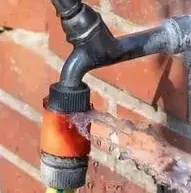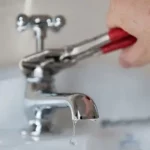Faucets just like other plumbing elements can break and cause a leaking hole on the stem. These holes are not good news.
Even if they are small and insignificant, they can cause water damage to your whole property. Therefore, the holes need to be attended to as soon as they are noticed to prevent bigger problems.
What causes a faucet to leak from hole in stem
Several reasons cause a faucet to leak from a hole in stem. These include:
1. Faulty O-ring
This is a very common cause especially if you have a cartridge faucet. The cartridge is the valve in the faucet that controls the water flow into the faucet spout.

If it is leaking, then it means that it is loose or worn out. To add to that, a problem with the sink handle can cause a faulty O-ring.
2. Corroded valve seat
The valve seat is the part that connects the faucet to the spout. If the leak is coming from the spout, then the problem may be at the valve seat.
This problem is caused by too much sediment build-up that corrodes the valve seat to cause leakage.
3. Worn-out washers
If you notice that you have a faucet leak from a hole in stem, worn-out washers can be the cause.
Washers sit against the valve and the friction that occurs in that area can lead to them getting damaged.
To add to that, leaks can happen if the washer is not properly installed or if you bought an oversize or small size washer that does not fit properly. Also, when washers are replaced wrongly they can cause leakages.
4. Worn out seals
Seals are other parts where leaks can occur. When you allow water to accumulate in the seals, the inlet and outlet seal are at risk of corrosion.
Stagnant water around the seals leads to easy corrosion. This is a problem that is mostly overlooked because it is usually hard to ascertain whether there is stagnant water around the seals or not.
5. Loose Parts
If there are loose parts in the installation of a faucet, then you are likely to deal with leaks within no time. Adjusting rings and packing nuts are likely to get loose over time and can cause leakages.
To prevent leaky faucets, these two parts have to be regularly checked.
6. Broke parts
If any parts break during the installation process or any other time, leaks can occur in faucets. Any part of the faucet can break and once this happens repair should be done as soon as possible.
Fixing broken parts may require a professional if you are not sure how to go about it.
How to fix a faucet leaking from hole in stem?
Fixing a faucet leaking from a hole in stem can be fixed in two ways.
Fixing Faucet Leaking from Hole in Stem when the Water Is Turned On

If water is leaking from the faucet when water is turned one of the above-listed reasons can be the causative factor. The following is a process to fix the leakage:
- Locate the exact position of the leak.
- Turn off the water flow using the turn-off valve
- Disassemble the faucet and access it to see whether any of the parts are worn out or broken
- Replace the worn-out parts that you can. If you cannot call a plumber.
- Reassemble the faucet
- Make sure everything is screwed tightly to ascertain that there are no loose nuts
- Turn the water flow on and access whether the leakage has stopped.
If the issue is the faucet, it will need replacing. If you cannot do it on your own, call in a plumber.
Fixing Faucet Leaking from Hole in Stem when the Water Is Turned Off
When this happens then you have a more serious issue. This mostly indicates that there is a crack in the pipes or there is something wrong with your plumbing structure.
For example, during winter pipes can freeze and the pressure can make them burst.
When the faucet is leaking from the hole in the stem then you will need to call in a professional plumber for help because you may not be able to deal with the plumbing structure problem
Tips to prevent leaking faucet
A leaky faucet is a pervasive problem that can lead to water and faucet damage. To prevent leaking faucets, the following can be done:
1. Proper installation
If faucets are installed properly then the chances of the leaking are minimal. During installation, faucet repair kits should be used for the best results.
Also, valves and water supply lines should be properly tightened. Additionally, hiring a professional to do the installation will always guarantee great results.
2. Faucet maintenance
Replacing worn-out seals after a year or two is a good way of maintaining your faucet. Also, clean your faucet with soap and water or with vinegar and baking soda once in a while heap keep the faucet clean.

3. Check the water pressure
High water pressure can cause leakage in the faucet. Therefore, pressure regulators should be used to maintain the required pressure.
4. Using new parts
When doing replacements new parts should be used. New valves, O-rings, washers, and spouts have minimal chances of causing leaks.
These parts should be of the preferred size.
5. Check the seals regularly
Worn-out seals cause faucet leakages. Therefore, checking them regularly and replacing the worn-out ones is very important
Why outdoor faucet has holes? How to fix it
Outdoor faucets have holes known as weep holes that prevent water from building up and filling the faucet. This hole is not a defect or an indication that the faucet is damaged.
Fixing a weep hole requires a hole to be drilled at the back of the outdoor faucet. They are small circles with small diameters.
The diameter of the weep holes varies by manufactures. A hole at the back of the faucet sounds like a simple task to do but weep holes should always be installed by professional plumbers.

As a homeowner, I am specifically keen on home improvement. I am passionate about homes, yards, and home improvement. I blog on home ideas and reviews on solutions that make homes better.